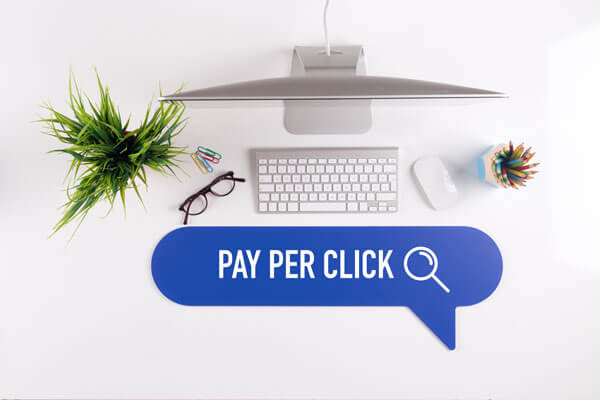
Pay Per Click. If you haven’t met and become best friends with these three words then sit up in your chair and get ready to learn how they will transform your business.
Everyone uses the internet to obtain answers to their questions and solutions to their problems. If you want to be the one to answer them then you need to be adverting on search engines and social media. A single click can become a new client. And a new client can become a new referral source. And those new referrals can become referral sources. And on and on and on. And all of this can happen from one click. So, a click is worth a lot.
There are two primary forms of advertising that use the Pay Per Click model – Search Engine Marketing (SEM) and social media advertising – and we will look at both platforms today.
In this article, we will provide an overview of SEM and Social Media Advertising, look at six reasons you should be utilizing them, and provide five tips to get you started.
What is Pay Per Click Advertising?
So, everyone understands how traditional advertising works. You pay a set amount per month to advertise on a billboard, run a television or radio spot, or publish a magazine or newspaper ad. That set amount is the same whether 5 people contact you or 500 people contact you. Pay Per Click advertising works the exact opposite way – you pay for every click you receive. If someone sees your digital ad but doesn’t click on it, you don’t pay.
That’s one big distinction between traditional advertising and Pay Per Click advertising, but there’s so much more to PPC. The two primary forms of PPC are Search Engine Marketing and social media advertising.
SEM primarily utilizes Google AdWords and Bing Ads to display ads about your company on Google or Bing. Here’s a quick overview of how it works:
- Determine your reach: Do you want your ads to show up in a zip code, city, mile radius of a city, entire states, or globally? Those all are options.
- Select your keywords: What words do you want to show up on the search engines? You can create a list of hundreds of words that are relevant to your services and when someone types in that word, your ad shows up.
- Choose your ad type: There are multiple ad types with Google AdWords and Bing Ads and the cost per click ranges based on the campaign type you choose.
- Set your budget: SEM works on a bidding system, meaning you pay based on how many other people are bidding on the same words (plus a few other metrics that Google and Bing decide). You can set your budget based on a daily spend, a max price per click, and more.
- Write your ad: If someone is in your geographical area and they have typed in a word you are bidding on, then your ad will show up. When you are writing your ad, you want to make sure it’s clear and enticing.
- Decide where to direct people: When leads click on your ad, you will need to send them somewhere, and it’s almost never the home page of your website. You want to send them to a page that clearly explains what they are looking for based on what they searched. This is known as a landing page.
Ads on this platform can show up in the form of 2-3 lines of text, images, and shopping ads. And it’s not just about clicks. There’s calls, too! You can have an entire campaign focused on generating phone calls, which is especially engaging for mobile advertising.
Social media advertising carries some of the same attributes as Search Engine Marketing with a few variations. It’s also based on reach, has multiple ad types, works off a fixed budget that you set, shows an ad you created, and can send people to a link that you choose. But, there’s a few differences:
- More specific demographics: Beyond a geographical region and targeted websites, social media advertising can place ads in front of your audience based on the info people share on social, which is a lot! We’ll discuss this more below.
- Design focused: Ads are very visual on social media and allow for graphics, videos, and text.
- Cheaper per click: On average, a click on social media will cost significantly less than it will on a direct Google or Bing search and there is less variation based on industry.
Ads on social media also have multiple placement options, from news feed to mobile to boosted posts.
Six Reasons Your Advertising Budget Should Be Heavily Allocated to Pay Per Click Advertising
If you can’t tell from the above descriptions, we strongly believe that Pay Per Click advertising is a very important form of advertising and one that should occupy a high percentage of your advertising budget. Here’s six reasons why.
- Targeted: PPC is the most targeted form of advertising. With SEM, you can target based on geographical region, searched words, interests, and more. With social media advertising, the targeting options are endless – you can target by age, race, gender, household income, interests, relational status, industry, employer, and much more!
- Flexible: No contracts, no set fees, and no set demographics. If you want to pause your PPC campaign, you can. If you want to increase or decrease your budget, you can. If you want to have your ads start showing up in a completely different city and to a completely different audience, you can. And you can do all of this within minutes.
- Defined Budget: With PPC, you determine how much you want to spend per click, per day, and more. You can also get immediate data on how much each click costs per campaign.
- Strong ROI: With PPC, your advertising is very specific. You are putting your message in front of the right demographics and you aren’t charged unless they are interested (and click).
- Instant Traffic: With PPC, you can instantly drive traffic to your website. Within minutes of setting up a campaign, you will have the right people clicking to your website.
- Measurable Results: Digital marketing, specifically PPC, offers excellent reporting. You can view your average number of clicks, average cost per click, ad performance, and more. Add in a call tracking number and landing pages and you’ll be set!
Getting these campaigns setup and effectively running can transform your business. We have a few tips to help you get started.
Five Tips To Get You Started With Pay Per Click Advertising
- Create landing pages: When someone clicks on your ad, they should be directed to a page that answers their question, explains why they should work with you, and offers multiple ways for them to get in touch with you. Most times, this will not be a page that already exists on your website but will need to be a new page. For example, you may notice more detail, a tracking URL, multiple call to actions, or a free resource on a landing page.
- Offer a resource: When people visit your website, you want to leave them with something so they are more likely to return. Maybe it’s a link to a video series, a downloadable resource such as an eBook, or an opportunity to signup for your eNewsletter.
- Respond quickly: If someone clicks on your ad and completes a contact form, they have entered your sales funnel. You need to immediately respond to them and take excellent notes about what they need so that you can properly follow-up with them and progress to the next stage of converting them to a client.
- Create, Test, Refine: One of the best features of the Pay Per Click model is the data. With A-B ad testing, you can create multiple ads and grade their performance based on metrics that you set. Managing a PPC campaign takes daily work to fully maximize the results. You’re not done after you create your ads … you’re just getting started!
Need Some Help?
If you’re ready to get started with pay per click advertising but aren’t sure where to begin, contact one of our account managers today by emailing us at hey@mandr-group.com or calling 478-621-4491. We manage PPC campaign every day for a wide range of clients and we are AdWords certified as well. We’re here to help!

